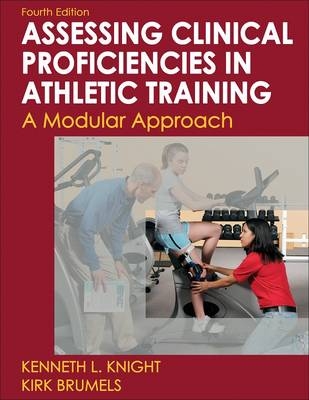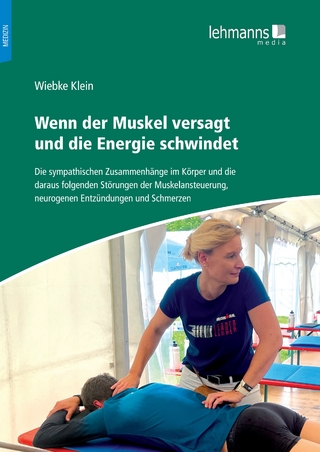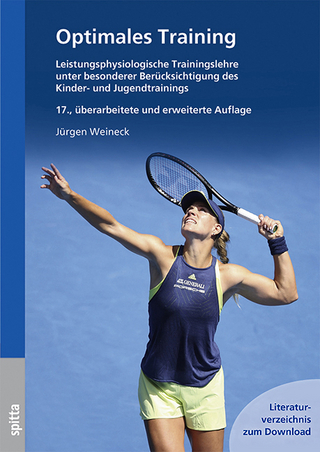
Developing Clinical Proficiency in Athletic Training
Human Kinetics (Verlag)
978-0-7360-8361-4 (ISBN)
- Keine Verlagsinformationen verfügbar
- Artikel merken
The fourth edition of Developing Clinical Proficiency in Athletic Training: A Modular Approach takes the skills that athletic training students need and organizes them into a modular system that will help students progressively develop while providing instructors with a systematic means of assessing their students' learning. The manual presents a flexible system consisting of three levels that are broken down into 146 modules used for assessing students' clinical skill development over the course of their athletic training program. The text is presented in such a way that it allows instructors to adjust the order of presentation of the modules while maintaining a complete record of the competencies achieved.
Previously titled Assessing Clinical Proficiencies in Athletic Training, this latest edition guides students and clinical instructors through the maze of educational competencies required of entry-level athletic trainers. All of the current National Athletic Trainers' Association (NATA) Athletic Training Competencies are embedded in the text. Because it covers all the competencies, this workbook can be used in conjunction with any athletic training text. The NATA competencies are noted in each module and are cross-referenced in an appendix. The following are new features of the fourth edition:
-Coathor Dr. Kirk Brumels joins author Ken Knight as a veteran clinic educator and a longtime user of the modular system.
-The 26 new modules enhance the existing modules and improve the coverage of competencies from the previous edition.
-Three new groups of modules are included: Developing Clinical Skill, The Body, and Professional Development.”
-A new module, Foundational Behaviors of Professional Practice, has been added to all three levels to ensure that students and clinical instructors have an ongoing dialogue concerning these behaviors.
In the fourth edition of Developing Clinical Proficiency in Athletic Training, the authors have reduced the number of levels from four to three and increased the number of modules in order to give instructors greater flexibility in adapting the text to their curriculums. They also have included more introductory material to help students and instructors better understand the integrated nature of athletic training education, and they discuss the nature of critical thinking and why it is essential to clinical practice.
The text's unique concept allows for multiple evaluations of proficiencies in the classroom, laboratory, and clinical settings. Through the modules, students are given the opportunity to demonstrate mastery of clinical proficiencies as instructors gauge their competencies across multiple exposures throughout the training experience. This approach ensures that students demonstrate both knowledge and the practical skills they need in order to be successful athletic trainers. As such, it is a great tool for instructors and the jump-start that students need as they prepare to move into their careers as athletic trainers.
Developing Clinical Proficiency in Athletic Training, Fourth Edition, is part of Human Kinetics' Athletic Training Education Series. Featuring the work of respected athletic training authorities, this collection of six outstanding textbooks, each with its own supporting instructional resources, parallels and expounds on the content areas in the accreditation standards of the NATA Educational Council.
Kenneth L. Knight, PhD, is professor of athletic training at Brigham Young University, past chair of the National Athletic Trainers' Association (NATA) Education Council, former editor in chief of the Journal of Athletic Training, and founding editor of the Athletic Training Education Journal. He has been involved in athletic training education for over 40 years and practiced athletic training for 25 years at the high school, junior college, and collegiate levels. Knight has taught more than 2,500 students. He was inducted into the NATA Hall of Fame in 2001, the Utah Athletic Trainers' Association Hall of Fame in 2003, and the Rocky Mountain Athletic Trainers' Association Hall of Fame in 2005. He was also named a Most Distinguished Athletic Trainer in 2000 by the NATA. Knight received the Sayers “Bud” Miller Outstanding Educator Award in 1995 and the Clancy Medal for Outstanding Research in Athletic Training from the NATA in 1995 and 1997. He also is the author of Cryotherapy: Theory, Technique and Physiology; Cryotherapy in Sport Injury Management; and Therapeutic Modalities: The Art and Science. Kirk Brumels, PhD, is an associate professor of kinesiology at Hope College in Holland, Michigan. He has been a practicing athletic trainer for more than 20 years, including 11 years in the National Football League with the New England Patriots where he was a member of the 1997 NFL Athletic Training Staff of the Year. Brumels serves as a clinical athletic trainer, didactic and clinical instructor, and director of the athletic training education program at Hope College.
Chapter 1. Philosophy of Clinical Skill Development
By Design or by Chaos
An Integrated Curriculum
Three Types of AT Education
Classroom, Clinical Skills, Clinical Experience
The Role of the Clinical Instructor
Clinical Education vs Clinical Experience
Principles of Clinical Education
Chapter 2. Module Program Overview
Flexibility in Program and Individual Modules
Using This Manual and the Modular Approach
Module Completion
Customizing—The Key to Flexibility
Oral/Practical Examinations
Level 1: Introduction to AT Clinical Education
Directed Clinical Experience
X1 Athletic Training Observation
X2 Athletic Training Clinic Student Staff
X3 Athletic Training Clinic Student Staff
Developing Clinical Skills
A1 Philosophy & Principles of Clinical Education
A2 Becoming a Critical Thinking Clinician
A3 Foundational Behaviors of Professional Practice
Athletic Training Clinic Operations
B1 Administrative Policies and Procedures
B2 Injury Record Keeping
B3 Athletic Training Supplies
B4 Athletic Training Clinic Equipment—Small
B5 Athletic Training Clinic Equipment—Major
E6 Basic Health Care Nomenclature
Emergency and Acute Care of Injuries and Illnesses
C1 Emergency and Acute Care Philosophy
C2 Principles of Initial Assessment
C3 Emergency Action Plans
C4 Cardiopulmonary Resuscitation
C5 Choking, Hemorrhaging, and Shock
C6 Emergency Transportation
C7 Medical Services (Health Center, Hospitals, Physicians)
C8 Rest, Ice, Compression, Elevation, and Support
C9 Open Wounds
C10 Universal Precautions Against Bloodborne Pathogens, Hepatitis, and Tuberculosis
C11 Environmental Injury/Illness
C12 Anaphylaxis and Asthma Attacks
C13 Poison Control Center
Level 2: Individual AT Skills Development
Directed Clinical Experience (Athletic Training Staff)
X4 Foundational Behaviors of Clinical Practice 2'
X5 Football Team Experience
X6 Basketball Team Experience
X7 Men's Team Sport Experience
X8 Women's Team Sport Experience
X9 Men's Individual Sport Experience
X10 Women's Individual Sport Experience
X11 High School Experience
X12 Sports Medicine Clinic Experience
Peer Teaching/Supervision
T1 Teach Level 1 Athletic Training Students
Surgical Procedures
D1 Basic Surgical Procedures
D2 Surgical Observation
The Body
E1 Body Systems and Development
E2 Injury and Illness Pathology
E4 Exercise & Disease
E4 Body's response to injury
Taping, Wrapping, Bracing, and Padding
F1 Ankle Taping, Wrapping, and Bracing
F2 Knee Taping, Wrapping, and Bracing
F3 Thigh and Lower Leg Taping, Wrapping, and Padding
F4 Foot Care, Taping, Wrapping, and Padding
F5 Hip and Abdomen Taping, Wrapping, and Bracing
F6 Shoulder Taping, Wrapping, and Bracing
F7 Elbow-to-Wrist Taping, Wrapping, and Bracing
F8 Hand and Finger Taping and Wrapping
F9 Head and Neck Padding and Bracing
Risk Management
G1 Injuries Happen
G1 Anthropometric Measurements and Screening Procedures
G2 Protective Equipment Fitting
G3 Ergonomics and Injury Prevention
G4 Fitness Testing
G5 Developing Flexibility
G6 Strength Training
Basic Pharmacology, Nutrition, and Wellness
H1 Medication Resources
H2 Medication Policies and Procedures
H3 Basic Performance Nutrition and Supplementation
H4 Eating Disorders
H5 Concepts in Health and Wellness
General Assessment and Evaluation
I1 Orthopedic Injury Assessment Principles
I2 General Medical Assessment
I3 Postural Assessment
I4 Neurological Assessment
I5 Palpation
I6 Assessing Range of Motion and Strength
I7 Physical Performance Measurements
Specific Injury Assessment and Diagnosis
J1 Foot Injury Assessment & Diagnosis
J2 Ankle Injury Assessment & Diagnosis
J3 Lower Leg Injury Assessment & Diagnosis
J4 Knee Injury Assessment & Diagnosis
J5 Thigh, Hip, and Pelvic Injury Assessment & Diagnosis
J6 Thorax and Lumbar Spine Injury Assessment & Diagnosis
J7 Thorax and Abdominal Injury Assessment & Diagnosis
J8 Shoulder Injury Assessment & Diagnosis
J9 Arm and Elbow Injury Assessment & Diagnosis
J10 Wrist and Hand Injury Assessment & Diagnosis
J11 Cervical Spine Injury Assessment & Diagnosis
J12 Head and Facial Injury Assessment & Diagnosis
General Medical Conditions
K1 Simple Dermatological Conditions
K2 Common Syndromes and Diseases
K3 Common Viral and Respiratory Tract Conditions and Disorders
K4 Common Cardiovascular and Gastrointestinal Tract Conditions and Disorders
K5 Common Genitourinary, Gynecological, and Sexually Related Conditions Disorders, and Diseases
K6 Sudden Illnesses and Communicable Diseases
Therapeutic Modalities
L1 Therapeutic Modality Foundation
L2 Whirlpool
L3 Moist Hot Packs
L4 Paraffin Bath
L5 Cryotherapy
L6 Cryokinetics
L7 Cryostretch
L8 Intermittent Compression Devices
L9 Ultrasound
L10 Diathermy
L11 Electrical Stimulation
L12Therapeutic Massage
L13Traction
Therapeutic Exercise
M1 Range of Motion and Flexibility Exercises
M2 Joint Mobilization
M3 Isometric Resistance Exercises
M4 Isotonic Strength-Training Devices
M5 Daily Adjustable Progressive Exercise
M6 Isokinetic Dynamometers
M7 Muscular Endurance
M8Aquatic Therapy
M9 Neuromuscular Control and Coordination Exercises
M10 Muscular Speed Exercises
M11 Agility Exercises
M12 Plyometrics
M13 Cardiorespiratory Endurance
M14 Activity-Specific Skills
M15 Exercise for the Young and Old
Examination
O/P1 Oral/Practical Examination 1
Level 3: Integrating and Polishing Skills
Directed Clinical Experience
X13 Foundational Behaviors of Clinical Practice
X14 Team Athletic Training Student
X15 Clinical Capstone Experience
X16 Traveling with Athletic Teams
Peer Teaching/Supervision
T2 Supervise/Teach Level 2 Students
T3 Administer O/P Examination 1
T4 Supervise/Teach Level 3 Students
T5 Administer Comprehensive 'O/P Examination
T6 Write O/P Questions
T7 Update Reference Material
Integrated Injury Management
N1 Musculoskeletal Assessment and Diagnosis
N2 General Medical Assessment and Diagnosis
N3 Emergency and Acute Care
N4 Rehabilitation Overview
N5 Rehabilitation Adherence and Motivation Techniques
N6 Rehabilitation Planning and Supervision
Health Care Administration
O1 Program Policies & Procedures
O2 Human Resources & Personal Management
O3 Facility Management
O4 Fiscal Management
O5 Information and Data Management
O6 Preparticipation Medical/Physical Examination
Psychosocial Interactions
P1 Healthcare [Patient] Communication
P2 Substance Abuse
P3 Psychosocial Intervention
Professional Development
Q1Regulation of Athletic Training Practice
Q2 Athletic Trainer in the Community
Q3 The NATA
Q4 Interpret Current Literature
Q5 Professional Presentation (in the community?)
Q6 Presenting Yourself to the Job Market
Examination
O/P2 Oral/Practical Examination 2
O/P3 Oral/Practical Examiner
Appendix A: Information for Customizing Modules
Appendix B: O/P Examination
Appendix C: Appendix C NATA Competencies and Module Finder
Appendix D: Master Module Completion File References
About the Authors
| Erscheint lt. Verlag | 6.11.2009 |
|---|---|
| Zusatzinfo | 8.5 |
| Verlagsort | Champaign, IL |
| Sprache | englisch |
| Maße | 216 x 279 mm |
| Gewicht | 1021 g |
| Themenwelt | Medizin / Pharmazie ► Medizinische Fachgebiete ► Sportmedizin |
| Medizin / Pharmazie ► Physiotherapie / Ergotherapie ► Rehabilitation | |
| ISBN-10 | 0-7360-8361-8 / 0736083618 |
| ISBN-13 | 978-0-7360-8361-4 / 9780736083614 |
| Zustand | Neuware |
| Haben Sie eine Frage zum Produkt? |
aus dem Bereich


